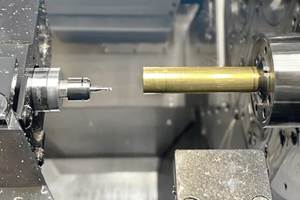Turning The Downside Up
An Ohio shop uses inverted-spindle machines to improve production of a high-volume part.
Share


Hwacheon Machinery America, Inc.
Featured Content
View More


Takumi USA
Featured Content
View More


.png;maxWidth=45)
DMG MORI - Cincinnati
Featured Content
View MoreThe northwest corner of Ohio offers a pleasant throwback to the slower pace of early American life. In this idyllic region, small towns with well-tended homes are separated by wide expanses of fertile farmland. With a population of only about 1,500, Stryker, Ohio, seems an unlikely locale for a modern, 53,000-square-foot machining facility. But for 92 years, Dalton Corporation (Warsaw, Indiana) has flourished in small-town environments.
Since Donald J. Dalton established the firm in Warsaw in 1910, it has grown steadily, enduring substantial changes in the manufacturing field. For example, during its earliest stage, the principal product of Dalton Foundries was a cast-metal cobbler's kit for do-it-yourself shoe repairs. Throughout the Great Depression, the company remarkably managed to sustain operations without furloughing a single employee. During World War II, Dalton substantially expanded its operation to meet wartime needs, producing cast parts for bombs, mortar shells and gun mounts.
Today, Dalton is owned by Neenah Foundry Corporation (Neenah, Wisconsin), a property of the ACP Holding Company. The foundries it operates in Warsaw and Kendallville, Indiana, produce precision gray iron castings primarily for the automotive, air conditioning/refrigeration and appliance markets. Established in 1989, the Stryker Machining Facility represents a vertical addition to the firm. Using castings from Dalton's foundries, this facility manufactures finished parts and assemblies for the firm's primary customers.
The plant's non-union workforce comprises approximately 80 people, drawn primarily from the local area. In cooperation with a technical education program at Northwest Community College in nearby Archbold, Ohio, the Stryker plant has a complete, internal training program for young metalworkers.
In September 2000, general manager Alan Sheets attended the IMTS in search of improvements to a key machining process that accounts for a substantial portion of the Stryker plant's work. This search led Dalton to adopt a fundamentally different approach to turning operations that has had a dramatic impact on the company's productivity.
The One-Part Process
As in the company's early days, production of one key product continues to represent a very important element in Dalton's overall business mix. This particular part is a clutch cylinder that is used on many rear-wheel-drive vehicles. Running three daily shifts from Monday through Friday, the Stryker plant annually produces approximately 800,000 of these precision parts. Because of this high throughput, the parts are always machined from freshly cast gray iron castings delivered on a just-in-time basis from the company's foundry. Regarding the benefits of this arrangement, Mr. Sheets says, "Because we can precisely coordinate our deliveries of raw castings, we're able to maintain just 2 days supply at our facility and keep our work-in-progress to a minimum."
Castings for the clutch cylinders meet SAE J431 G-2500 specifications with hardness in the range of 187-229 HB. Because Dalton has control of the entire casting process, the Stryker facility enjoys some key advantages compared to shops that order castings from outside suppliers. "We utilize a joint task force group that coordinates operations between the foundry and our facility," says Mr. Sheets. "Machinability and material variations are continuously reviewed and documented."
When gray iron is cast in a green sand process, the metal's machinability is enhanced by employing a slower and more uniform cooling process that allows fine particles of graphite to form within its surface structure. By exercising strict control of pouring and cooling temperatures in the foundry, Dalton has the capability to fine-tune the machining properties of its castings. When the original machining process for the clutch cylinders was developed, Mr. Sheets found that using coolant to machine the castings created problems with part-corrosion and chip-recycling. As a result, the shop now uses only dry machining to produce these parts.
In the past, Dalton ran the parts exclusively on twin-spindle horizontal machining centers that require manual loading and unloading. With the large number of parts being produced, this entails considerable ergonomic issues for machine operators. When a part is machined horizontally, its bowl-shaped form also presents problems with tool wear and part quality. Re-cutting and abrasion of chips that collect in the lower portion of the part increase tool consumption and adversely affect accuracy. This represents an important issue because certain critical dimensions of the part are subject to 100-percent verification.
To address these problems and to improve its overall production time for these important parts, Dalton purchased two CTV 250 vertical lathes supplied by DMG America (Schaumburg, Illinois). Each machine incorporates a linear drive on the X axis and accepts chucks up to 250 mm in diameter. Each machine is also equipped with 12 live tool stations and a 5,000-rpm spindle. The machines are controlled by Sinumerik 840 D CNCs from Siemens.
The clutch cylinder parts incorporate complex features that require various ID, OD and face-turning operations. With the vertical lathes' inverted spindles, cutting tools enter the cuts from below—and chips are evacuated instantaneously by gravity. For Dalton's application, this represents a significant improvement compared to conventional machine configurations. The new machines also incorporate substantially faster rapid traverse rates on all axes of motion to reduce idle time.
Dalton currently uses five different insert-type tools to machine the finished clutch cylinders from rough castings. For roughing cycles, the shop uses inserts coated with silica nitride, while finishing cycles are completed using standard carbide inserts. Dalton also manufactures the majority of tooling and fixtures that it uses. The company conducts a substantial number of tooling tests to improve the efficiency of its process.
To ensure precise control of the cutting tool length, Dalton uses dead-length collets. In this type of toolholder, the inner collet bears directly on the face of the spindle. Because the spindle's position doesn't change when the draw bar is actuated, the inner collet remains fixed. This configuration eliminates the pull-back effect associated with conventional collets.
Dalton also uses a conveyor system to take advantage of the vertical lathes' automatic loading capabilities. Using metal templates to simplify locating parts on the conveyors, the machine operator can load several parts at a time. Each machine's CNC displays the entire queue of finished and unfinished parts to give the operator an ongoing progress report. Instead of manually loading one part at a time with constant intervention to maintain production, Dalton's operators can now load enough castings onto each machine's conveyor to extend reloading intervals to 25 minutes or more. Combined with the lathes' auto-loading functions, this enables one person to tend both machines.
More Chips In Less Time
The most conspicuous index of metal-cutting efficiency is how quickly a shop fills its chip containers. According to Mr. Sheets, "roughly half of the 75 to 80 tons of chips that we move out of here every week are coming from our clutch cylinder production. With the vertical lathes, we've substantially reduced our average machining time for these parts."
Dalton has been able to cut its production time at the same time that it has reduced consumption of cutting tools. In addition, the new process allows the shop to consistently produce tighter-tolerance parts. This is significant in terms of Dalton's reputation for quality, because these efficiencies have been achieved while adding value to the company's products.
Mr. Sheets admits that recent economic conditions have caused a decline in his shop's workload. This is primarily due to scaled-back production in the automotive sector that accounts for 80 percent of the Stryker facility's work. Despite these conditions, however, adding new equipment has enabled the company to produce the clutch cylinders more profitably. Given the shop's current level of production, the two vertical lathes have sufficient capacity to address Dalton's needs. From experience, however, Mr. Sheets realizes that demand for clutch cylinders and similar parts will recover. When this occurs, Dalton will be positioned to add machining capacity quickly without needing to break in an entirely new process.
Dalton's experience reaffirms that fundamental changes in conventional thinking about machine tool design can have significant impacts on the shop floor. Remaining competitive in the modern world of metalworking requires the creativity to address both ordinary and extraordinary machining tasks with unconventional strategies. In a larger sense, Dalton's experience also confirms the wisdom of continuing to make prudent investments in new technology, regardless of business cycles.
Related Content
Finding the Right Tools for a Turning Shop
Xcelicut is a startup shop that has grown thanks to the right machines, cutting tools, grants and other resources.
Read More4 Commonly Misapplied CNC Features
Misapplication of these important CNC features will result in wasted time, wasted or duplicated effort and/or wasted material.
Read More3 Tips to Accelerate Production on Swiss Lathes with Micro Tools
Low RPM lathes can cause tool breakage and prevent you from achieving proper SFM, but live tooling can provide an economical solution for these problems that can accelerate production.
Read MoreQuick-Change Tool Heads Reduce Setup on Swiss-Type Turning Centers
This new quick-change tooling system enables shops to get more production from their Swiss turning centers through reduced tool setup time and matches the performance of a solid tool.
Read MoreRead Next
5 Rules of Thumb for Buying CNC Machine Tools
Use these tips to carefully plan your machine tool purchases and to avoid regretting your decision later.
Read MoreRegistration Now Open for the Precision Machining Technology Show (PMTS) 2025
The precision machining industry’s premier event returns to Cleveland, OH, April 1-3.
Read MoreBuilding Out a Foundation for Student Machinists
Autodesk and Haas have teamed up to produce an introductory course for students that covers the basics of CAD, CAM and CNC while providing them with a portfolio part.
Read More

























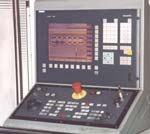
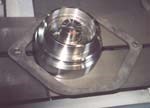
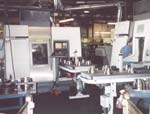

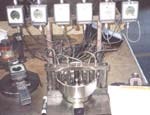







.jpg;maxWidth=300;quality=90)
.jpg;maxWidth=300;quality=90)












